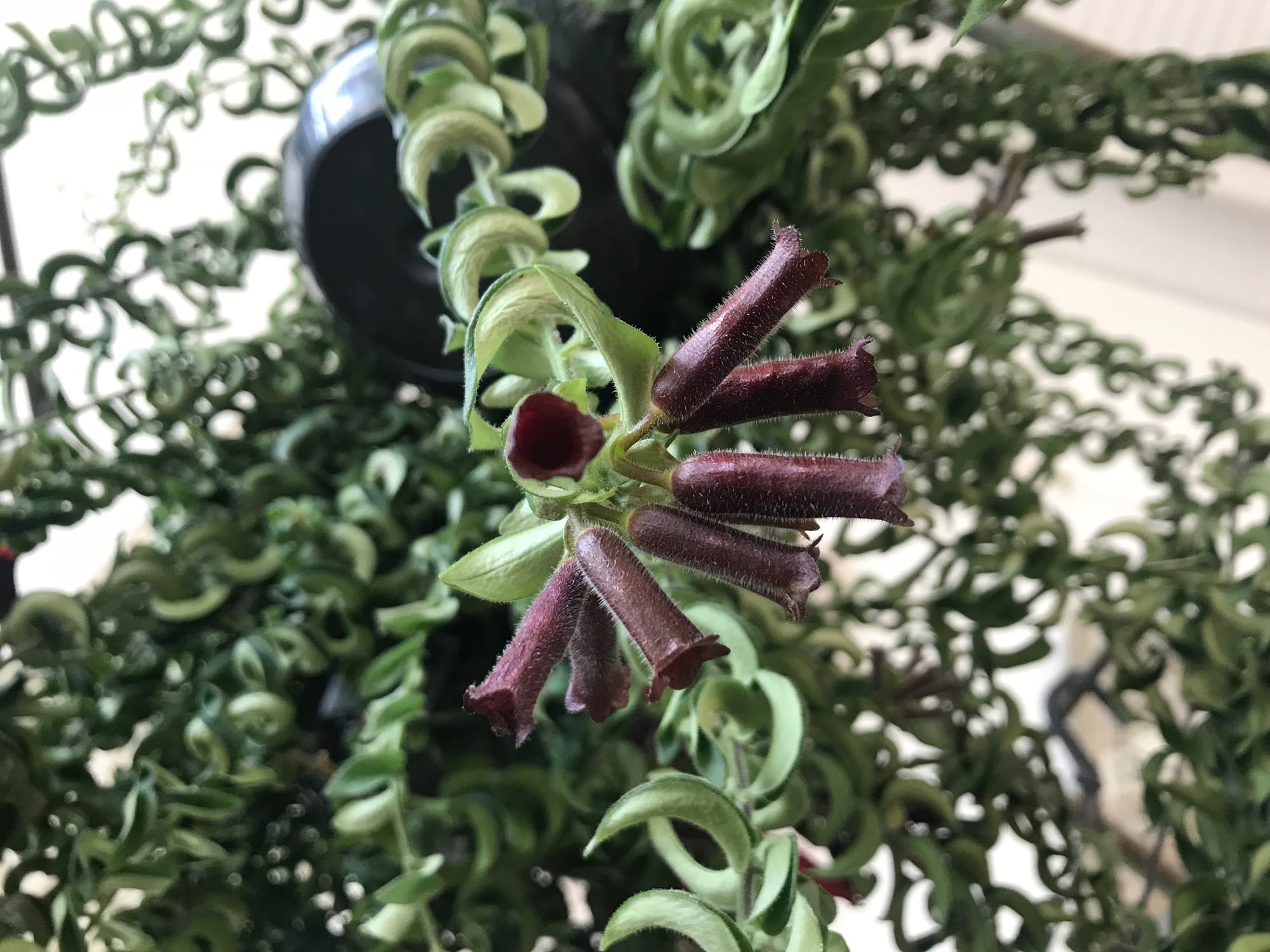
Aeschynanthus radicans
Listen to the Lipstick Plant Podcast here!
Contents
- Top Tips
- Location, Water, Humidity & Fertilisation
- Dormancy Care & Annual Flowers
- Common Issues
- Origins, Temperature, Propagation, Repotting & Toxicity.
Need the answer to a specific plant query? Book a 1-to-1 video call with THE HOUSEPLANT DOCTOR™, the website's friendly author, to overcome and address your niggling problem! Available on iMessage, WhatsApp, Facebook Messenger & more.
Top Tips & Info
- Care Difficulty - Moderate
- Keep the soil evenly moist, allowing the pot to feel light in between hydrations. It's advised to water the plant using the bottom-up method of submersion, for the prevention of rotting foliage (caused by excess moisture above the soil line).
- Provide a good level of humidity by introducing a pebble tray to keep the surrounding environment reliable.
- Bright indirect light is best, avoiding prolonged exposure to the sun, especially in the summer. A few hours of winter sunlight is highly beneficial for new growth, though.
- Fertilise using a 'Houseplant' labelled feed every four waters in the spring and summer, reducing this to every six in the colder months.
- Flowers will develop in the summer and will last up to a few weeks. Be sure to avoid persistent droughts whilst the plant is in the blooming process.
- In spring, repot every three years with 'Houseplant' compost. Water the plant 24hrs beforehand, to reduce the risk of damaging the root hairs. (Transplant Shock).
Location & Light - 🔸🔸
Provide a bright, indirect location that offers a reliable level of humidity, air circulation and temperature. A position that offers more than two hours of strong direct light must be kept off the cards, due to their susceptibility to sun-scorch. A site within three metres of a north, east or west-facing window, or below a skylight window is the ideal area.
Water - 🔸🔸
The rule of thumb with Lipstick Plants is to allow the top couple of inches to dry out in between irrigations - once the pot begins to feel light, it's time for another water. Reduce this further during winter to replicate their dormancy period. Whilst in bloom, avoid the use of cold water due to the species' sensitive nature to cold temperatures. Under-watering symptoms include little to no new growth, a much-needed transplant, and drying leaves - these issues are caused by too much sunlight, a much-needed transplant or pure forgetfulness. Over-watering symptoms include yellowing leaves that soon drop off, no or little growth and root rot.
Humidity - 🔸🔸🔸
High humidity needs to be empathised greatly. A weekly mist, or introducing a humidity/pebble tray will help replicate its natural habitat in the Brazilian forests. Botrytis petal blight and southern blight are caused when excess moisture (from misting or messy irrigations) is allowed to settle in the cubbyholes of the flowers or vines.
Fertilisation - 🔸🔸
Feed every four waters during the growing period and every six in the autumn and winter, using a 'Houseplant' labelled fertiliser. Never apply a 'Ready to Use’ product into the soil without a pre-water first, as it may burn the roots and lead to yellowed leaves.
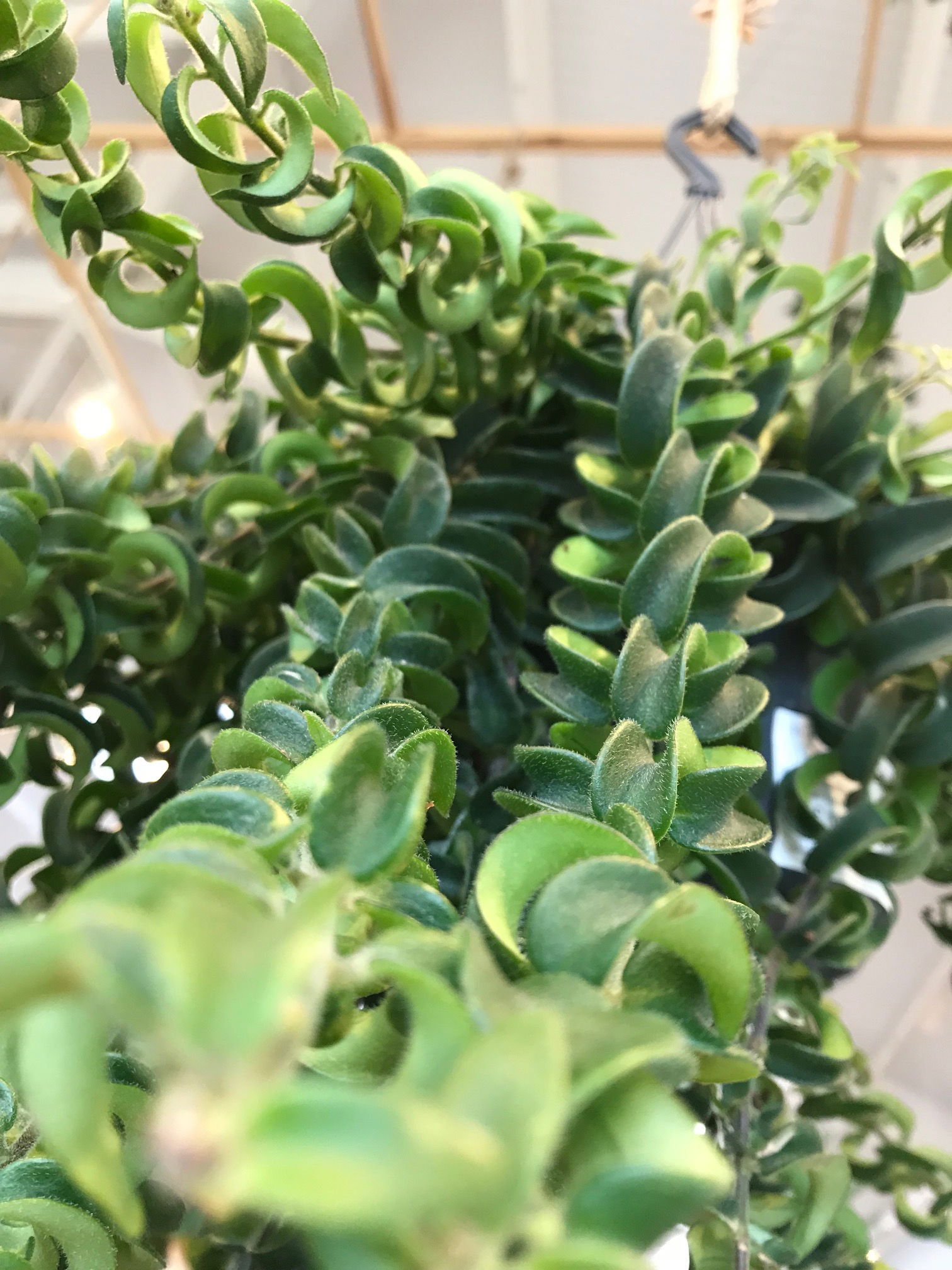 Aeschynanthus radicans
Aeschynanthus radicans
Dormancy Care & Annual Flowers
Trying to re-bloom a Lipstick Plant is relatively easy, with those that have a cool room without artificial light at night being on the upper-hand. Repotting isn't usually mandatory if you want it to re-bloom - in fact, this may hurt the chances. Only repot every two to three years and after the flowers have elapsed. To get it to bloom during the summer months, think back to its previous dormancy period served in the autumn and winter. The ukhouseplants' acronym, SHORT, will help you through this process.
The following steps should be done in the autumn and winter when Lipstick Plants enter their dormancy.
Sunlight
Be sure to provide a bright location with no direct sun over this period. Although the winter sunlight won't necessarily hurt the plant, you can easily fall in the trap of under-watering, potentially weakening it. In order for the plant to fully become seasoned, avoid the use of artificial lighting during the night.
Hydration
Reduce irrigations so that the majority of the soil becomes dry. Remember, they should only be watered from the bottom-up as rotting foliage are a common issue with cooler temperatures.
Occasional Feeds
While it's bloom, use a 'Houseplant' fertiliser to provide nourishment of potassium. During the dormancy period, only supplement once or twice to carry it through until the following spring, using a general houseplant fertiliser.
Reduce Everything
This one is to remind you that everything needs to be reduced - especially the temperature.
Temperature
This is the most significant step; reduce the temperature down by around 5℃ compared to the summertime or place in a room that's around 15℃ (59℉). The drop in temperature should ideally last until the inflorescence finishes blooming, although it can still be transferred into the main house as long as it sits on a pebble tray. You'll be at a significant disadvantage if the ambient temperature is kept constant throughout the year, as Lipstick Plants will only respond with flowers in cooled environments. Never exceed the minimum temperature as it could lead to plant death or yellowed foliage at a bare minimum.
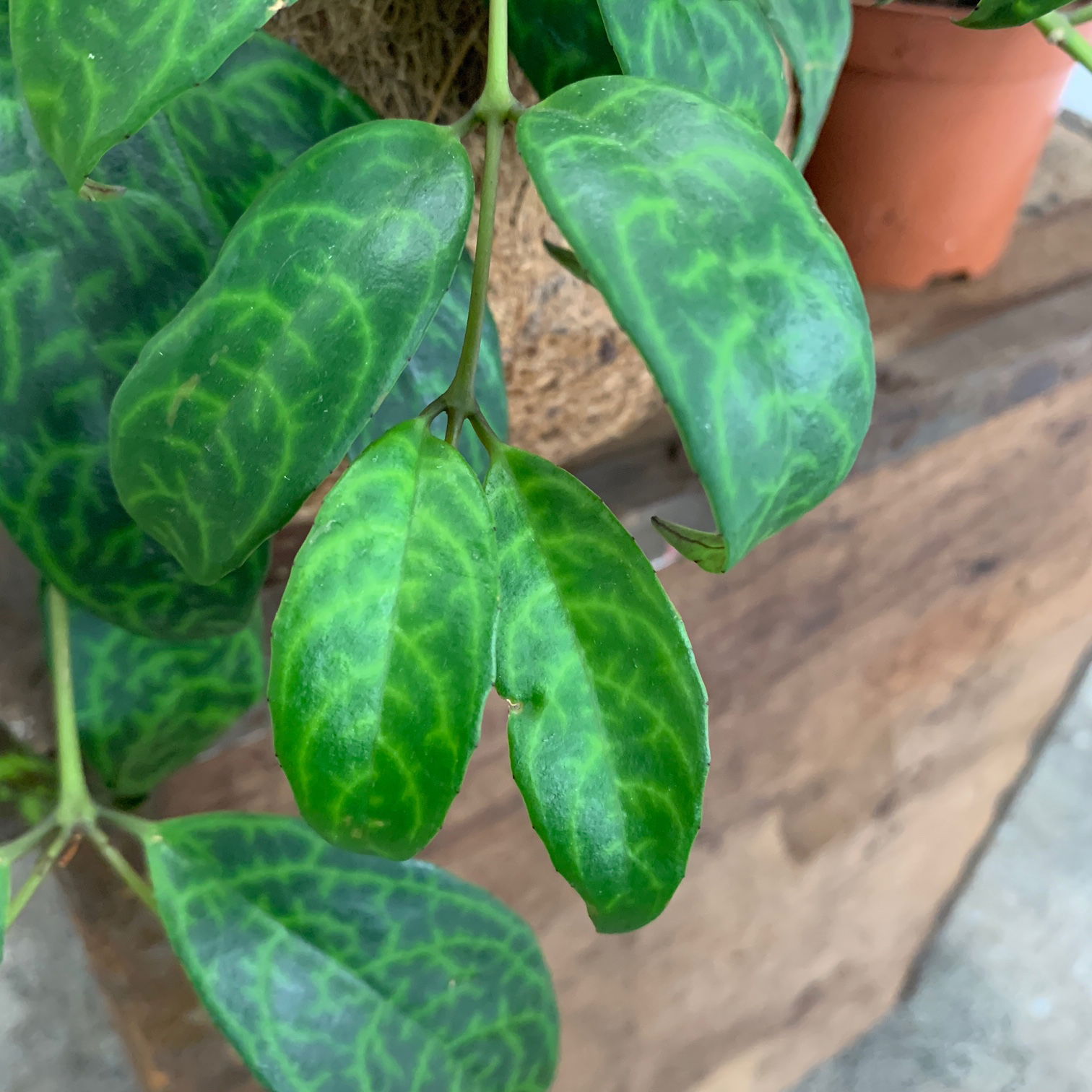 Aeschynanthus mamoratus
Aeschynanthus mamoratus
Common Issues with Lipstick Plants
Dry soil is a big issue when cultivating Lipstick Plants. Despite their ability to withstand short-lived droughts, persistent dry spells will considerably weaken the plant, causing shortened blooming times. Be sure to avoid direct sunlight and potentially create a watering-schedule if you're a forgetful gardener.
Green Aphids are also a common issue. These small, lime-coloured critters can easily blend in with the foliage, thus leading to rapid infestations. They are most likely to infest the juvenile growth or the flowers themselves, and can cause mottled lesions. The best way to prevent an attack before it becomes a threat is by keeping the windows and doors shut, with regular pest inspections. For those that have already bitten the dust, click on this link to learn about addressing these issues.
A lack of leaves on the soil’s top could be the product of excess moisture settling on the foliage. Although watering from the top is best, it's recommended to use the bottom-up method if you're a messy waterer. For specimens that have a bare head, improve growing conditions by using this method and increasing the light levels and air circulation. Take vine cuttings to promote a bushier appearance above the soil line - scroll down to 'Propagation' for more information. Finally, always remove yellowed or rotten debris from the soil as it could harbour both bacterial and fungal diseases, which will continue the plant's decline.
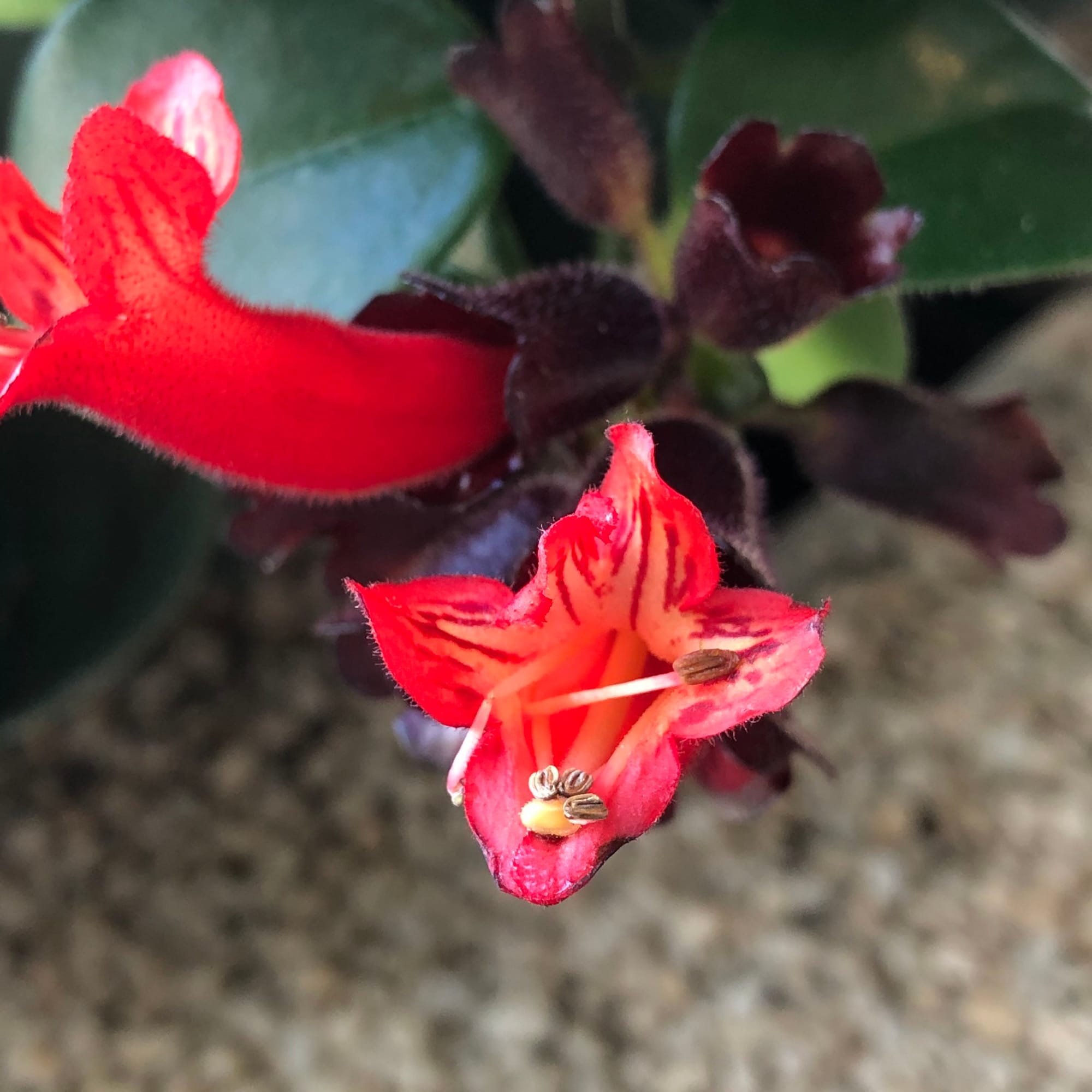 A lack of flowers could be caused by a poor dormancy period served in the previous autumn and winter. Scroll up to the previous section to learn more about achieving annual flowers!
A lack of flowers could be caused by a poor dormancy period served in the previous autumn and winter. Scroll up to the previous section to learn more about achieving annual flowers!
Root rot is a common issue among specimens sat in too dark environments with prolonged soil moisture. Symptoms include rapidly yellowing leaves, mouldy soil, stunted growth and a rotten brown base. Take the plant out of the pot and inspect health below the compost line. If the roots sport a yellow tinge, you're good to go, but if they're brown and mushy, action must be taken immediately. More information about addressing root rot can be found on this link.
Never situate one within four metres of an operating heat source, for instance, a heater or fireplace. Due to the heightened temperature, the plant will soak up far more moisture than those situated in cooler locations, increasing the chance of droughts and browning leaf-edges.
Too much sunlight will lead to sun scorch, with typical signs including browning or crispy leaves, dry leaf-edges, sunken leaves or stunted growth. Although too little light will cause over-watering issues, excess sunlight will be a detriment to the plant as well. If yours has fallen short of this, reduce the amount of the sun considerably and always be mindful of environmental shock (when two locations offer too different growing conditions). Remove some of the affected leaves and increase waters slightly.
As mentioned before, powdery mildew and southern blight are major threats among heavy foliage plants when excess moisture is allowed to sit on compacted foliage. Remove the affected areas and improve the growing conditions by situating the plant in a brighter location and keeping the leaves dry.
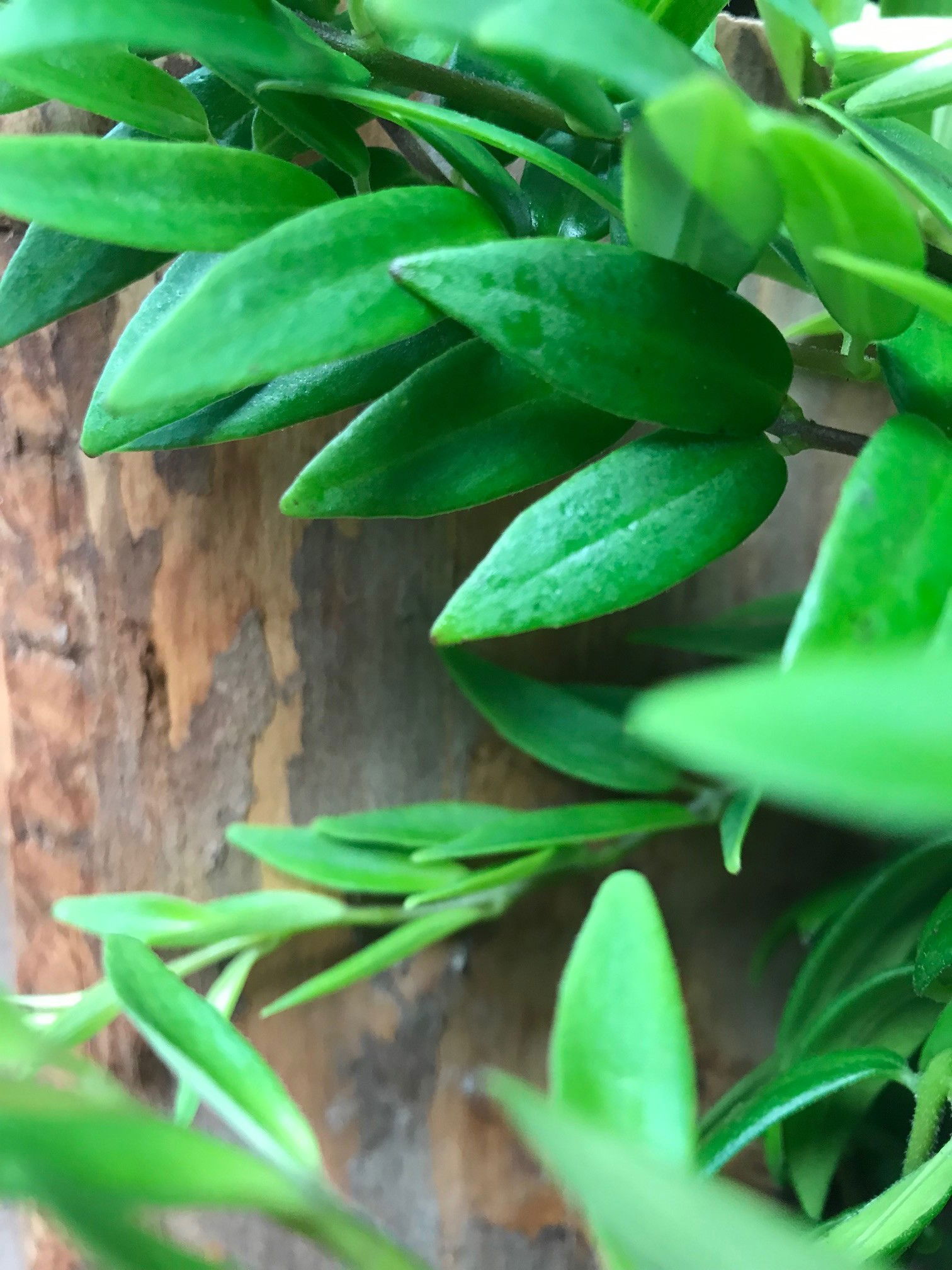 Aeschynanthus japhrolepis
Aeschynanthus japhrolepis
Origins
There are over one hundred and fifty known species of Aeschynanthus, all of which have distributions in Eastern Asia, such as the Solomon Islands and Papua New Guinea. They're part of the Gesneriad family that holds genera like Streptocarpus, Saintpaulia (African Violets) and Gloxinia. The genus was first classified in 1823 by William Jack, who used the Greek words aischuno, meaning 'to be ashamed of' and anthos referring to its flower that can resemble male phalli.
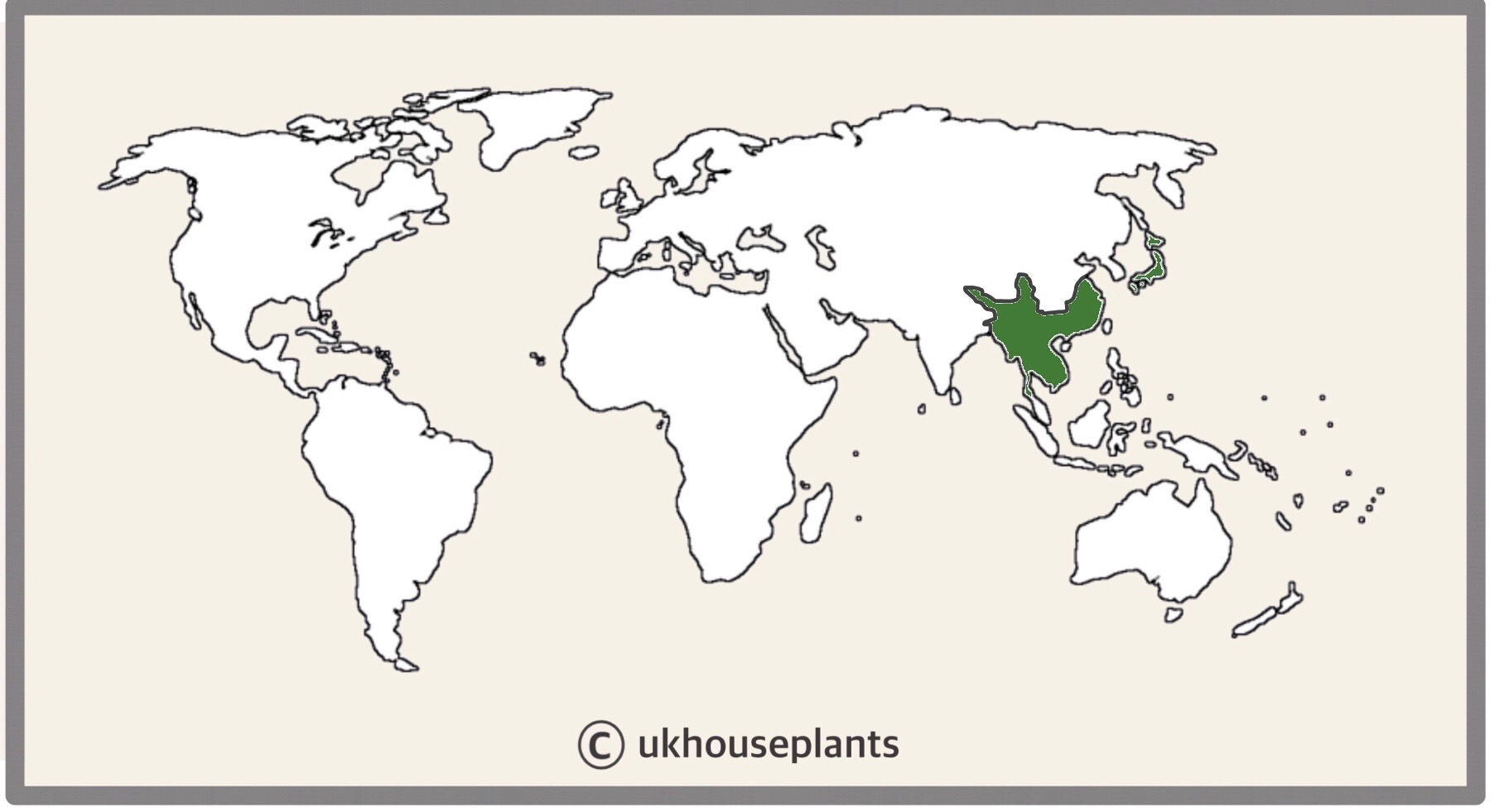 The Distribution of Aeschynanthus.
The Distribution of Aeschynanthus.
Temperature
15º - 26℃ (59º - 79℉)
H1a (Hardiness Zone 13) - Must be grown indoors or under glass all year round. Never allow temperatures to dip below 15℃ (59℉) or permanent damage may occur in the likes of flower loss, stunted growth and blackened or yellowed leaves.
Spread
Up to 1m in height (length) and 0.8m in width, with the ultimate height being reached in 3 - 6 years.
Pruning & Maintenance
Remove yellow or dying leaves, and plant debris to encourage better-growing conditions. While pruning, always use clean utensils or shears to reduce the chance of bacterial and fungal diseases. Never cut through yellowed tissue as this may cause further damage in the likes of diseases or bacterial infections. Pruning is recommended in the early spring to promote a more bushy appearance and the stimulation of potential flowers for the summer months.
Propagation
Via Seed or Vine Cuttings
Vine Cuttings
- 'Leaf & Eye' cuttings are the segregation of a vine into several sections, with each having just one node that houses the leaf (& eventually the roots) along with a piece of the stem.
- Once the cuttings are removed, you'll need some rooting powder. Although they'll still develop roots without the need of this hormone, success rates will be far lower.
- Use a five-inch pot that has good drainage holes - plastic or terracotta are both acceptable in this instance. Never over-pot the cuttings - blackleg occurs when the bottom wound becomes infected, typically caused by water-logging or a too-damaged wound.
- Set the cutting into the compost ('Houseplant' labelled soil is best), keeping the foliage above the soil line and the node slightly below it.
- Place in a bright, indirect location and offer good humidity by wrapping the pot into a transparent plastic bag for the first couple of weeks. Mist the cuttings, so that the soil around it becomes slightly moist. Keep the bag open for a few hours until most of the water droplets evaporate. This bag-trick is mandatory to slow the rate of transpiration (water loss via the leaves) - as soon as a stem is removed from its primary water source, it'll immediately begin to loose stored moisture and nutrients.
- Remove any rotten debris as this will cause an outbreak of bacteria.
- After around eight weeks, the cuttings should have rooted. Separate them into their own small pot and treat them like a normal houseplant. The use of the transparent bag is no longer needed but will help reduce the rate of transpiration.
Flowers
Lipstick Plants will put out flowers during the summer that can last several weeks. The shape of the flowers mostly resembles a red lipstick, which is thanks to the shape of the developing buds. Supplement using a potassium-based feed during the start of spring to encourage the chance of flowers; Streptocarpus Feed is an excellent choice as it holds an ideal blend of both nitrogen (foliar growth) and potassium for flower development.
 The nickname, Lipstick Plants, comes from the cylindrical-shaped flower buds that get put out in the start of summer.
The nickname, Lipstick Plants, comes from the cylindrical-shaped flower buds that get put out in the start of summer.
Repotting
Repot every two years in the spring, using a 'Houseplant' or 'Gesneriad' labelled potting mix and the next sized pot with adequate drainage. Lipstick Plants are far better being potbound for several years due to the heightened risk of root rot and repotting-issues (like transplant shock), so only repot if you feel it's wholly necessary - restricted root growth will also increase the chance of blooms, too.
Hydrate the plant 24hrs before tinkering with the roots to prevent the risk of transplant shock. For those situated in a darker location, introduce an extra amount of perlite and grit into the deeper portion of the pot to downplay over-watering risks. Click on this link for a detailed step-by-step guide on transplantation, or via this link to learn about repotting with root rot.
Book a 1-to-1 video call with Joe Bagley if you'd like a personal guide to repotting your houseplant. This will include recommending the right branded-compost and pot size, followed by a live video call whilst you transplant the specimen for step-by-step guidance and answer any further questions!
Pests & Diseases
Keep an eye out for spider mites, mealybugs, aphids, whitefly, root mealybugs, scale & thrips. Typical diseases associated with Lipstick Plants are leaf-spot disease, botrytis, powdery mildew & root rot. Click here for more information about how to identify and address any of these issues.
Toxicity
This plant is classified as poisonous, so if small sections are eaten, vomiting, nausea, and a loss of appetite may occur. Consumption of large quantities must be dealt with quickly; acquire medical assistance for further information.
Retail Locations
Online Stores.
Book a 1-to-1 Call with THE HOUSEPLANT DOCTOR™
If you need further advice with your houseplants, book an advice call with ukhouseplants' friendly and expert writer today! This can be done via a video or audio call on most apps, including Facebook, FaceTime & Skype. A ten-minute call costs £5.99 (US$7), or £15.99 for thirty minutes. You can ask multiple questions, including queries on plants, pests, terrariums, repotting advice and anything in between. Please consider supporting this service to keep ukhouseplants thriving!